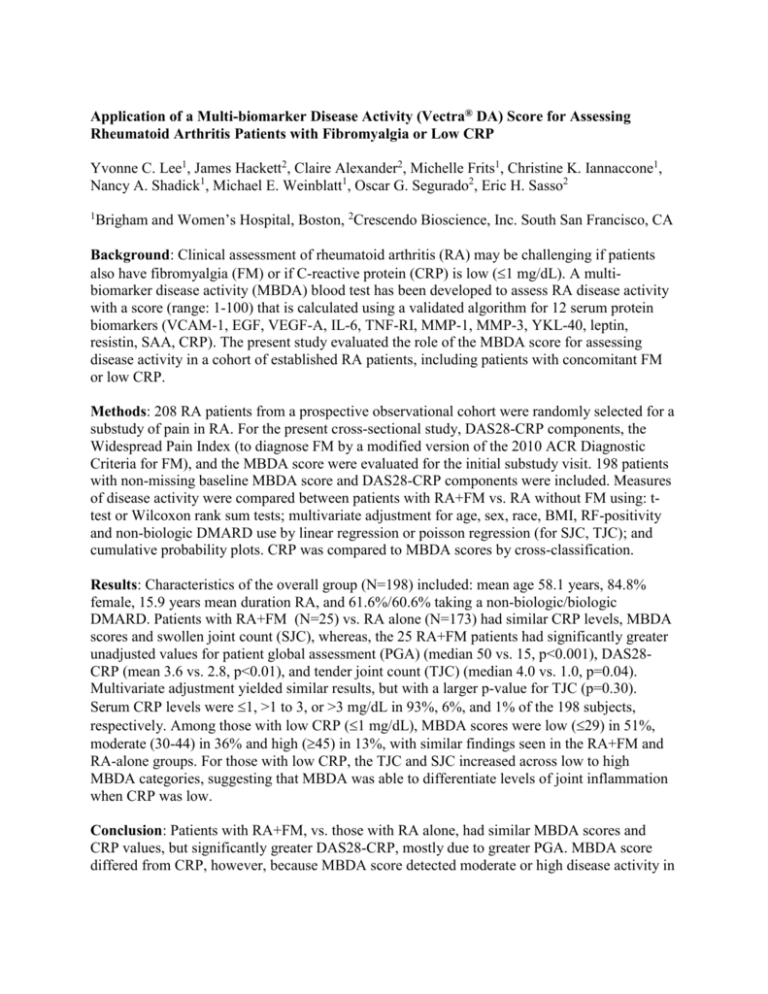Application of a Multi-Biomarker Disease Activity
advertisement

Application of a Multi-biomarker Disease Activity (Vectra® DA) Score for Assessing Rheumatoid Arthritis Patients with Fibromyalgia or Low CRP Yvonne C. Lee1, James Hackett2, Claire Alexander2, Michelle Frits1, Christine K. Iannaccone1, Nancy A. Shadick1, Michael E. Weinblatt1, Oscar G. Segurado2, Eric H. Sasso2 1 Brigham and Women’s Hospital, Boston, 2Crescendo Bioscience, Inc. South San Francisco, CA Background: Clinical assessment of rheumatoid arthritis (RA) may be challenging if patients also have fibromyalgia (FM) or if C-reactive protein (CRP) is low (1 mg/dL). A multibiomarker disease activity (MBDA) blood test has been developed to assess RA disease activity with a score (range: 1-100) that is calculated using a validated algorithm for 12 serum protein biomarkers (VCAM-1, EGF, VEGF-A, IL-6, TNF-RI, MMP-1, MMP-3, YKL-40, leptin, resistin, SAA, CRP). The present study evaluated the role of the MBDA score for assessing disease activity in a cohort of established RA patients, including patients with concomitant FM or low CRP. Methods: 208 RA patients from a prospective observational cohort were randomly selected for a substudy of pain in RA. For the present cross-sectional study, DAS28-CRP components, the Widespread Pain Index (to diagnose FM by a modified version of the 2010 ACR Diagnostic Criteria for FM), and the MBDA score were evaluated for the initial substudy visit. 198 patients with non-missing baseline MBDA score and DAS28-CRP components were included. Measures of disease activity were compared between patients with RA+FM vs. RA without FM using: ttest or Wilcoxon rank sum tests; multivariate adjustment for age, sex, race, BMI, RF-positivity and non-biologic DMARD use by linear regression or poisson regression (for SJC, TJC); and cumulative probability plots. CRP was compared to MBDA scores by cross-classification. Results: Characteristics of the overall group (N=198) included: mean age 58.1 years, 84.8% female, 15.9 years mean duration RA, and 61.6%/60.6% taking a non-biologic/biologic DMARD. Patients with RA+FM (N=25) vs. RA alone (N=173) had similar CRP levels, MBDA scores and swollen joint count (SJC), whereas, the 25 RA+FM patients had significantly greater unadjusted values for patient global assessment (PGA) (median 50 vs. 15, p<0.001), DAS28CRP (mean 3.6 vs. 2.8, p<0.01), and tender joint count (TJC) (median 4.0 vs. 1.0, p=0.04). Multivariate adjustment yielded similar results, but with a larger p-value for TJC (p=0.30). Serum CRP levels were 1, >1 to 3, or >3 mg/dL in 93%, 6%, and 1% of the 198 subjects, respectively. Among those with low CRP (1 mg/dL), MBDA scores were low (29) in 51%, moderate (30-44) in 36% and high (45) in 13%, with similar findings seen in the RA+FM and RA-alone groups. For those with low CRP, the TJC and SJC increased across low to high MBDA categories, suggesting that MBDA was able to differentiate levels of joint inflammation when CRP was low. Conclusion: Patients with RA+FM, vs. those with RA alone, had similar MBDA scores and CRP values, but significantly greater DAS28-CRP, mostly due to greater PGA. MBDA score differed from CRP, however, because MBDA score detected moderate or high disease activity in nearly half of patients with low CRP (1 mg/dL). Further study is needed to determine the clinical meaning of discordance between CRP and MBDA scores. Table 1. Disease activity measures for RA patients who met 2010 ACR diagnostic criteria for FM versus those who did not. Disease Activity Index RA + FM RA without FM Unadjusted Adjusted (N = 25) (N = 173) P-value1 P-value2 MBDA score 33 32 0.65 0.86 C-reactive protein (mg/dL) 2.0 1.6 0.84 0.72 Swollen joint count 1.0 1.0 0.38 0.40 Tender joint count 4.0 1.0 0.04 0.30 Patient global assessment 50 15 <0.001 <0.001 DAS28-CR 3.6 2.8 < 0.01 <0.01 Values for disease activity measures are medians unadjusted for covariates, except for MBDA score and DAS-28, which are unadjusted means. 2 P-values for unadjusted means by t-test; for unadjusted medians by Wilcoxon test. 3 P-values for multivariate (covariate-adjusted) analysis.











